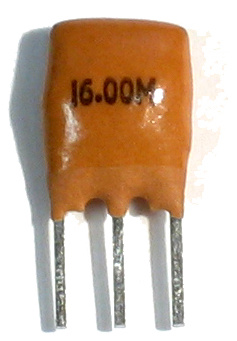Ceramic resonator

A 16MHz ceramic resonator
|
|
| Type | Electromechanical |
|---|---|
| Working principle | Piezoelectricity, Resonance |
A ceramic resonator is an electronic component consisting of a piece of a piezoelectric ceramic material with two or more metal electrodes attached. When connected in an electronic oscillator circuit, resonant mechanical vibrations in the device generate an oscillating signal of a specific frequency. Like the similar quartz crystal, they are used in oscillators for purposes such as generating the clock signal used to control timing in computers and other digital logic devices.
Ceramic resonators are made of high-stability piezoelectric ceramics, generally lead zirconium titanate (PZT) which functions as a mechanical resonator. In operation, mechanical vibrations induce an oscillating voltage in the attached electrodes due to the piezoelectricity of the material. The thickness of the ceramic substrate determines the resonant frequency of the device.
A typical ceramic resonator package has either two or three connections. They come in both surface-mount and through-hole varieties with a number of different footprints. The oscillation takes place across two of the pins (connections). The third pin (if present; typically the center pin) is connected to ground.
Ceramic resonators can be used as the source of the clock signal for digital circuits such as microprocessors where the frequency accuracy is not critical. Quartz has a 0.001% frequency tolerance, while PZT has a 0.5% tolerance.
...
Wikipedia
